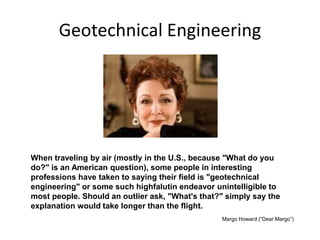The Ultimate Guide To Geotheta
The Ultimate Guide To Geotheta
Blog Article
Getting The Geotheta To Work
Table of ContentsThe Definitive Guide for GeothetaHow Geotheta can Save You Time, Stress, and Money.Some Of GeothetaGeotheta for Beginners
They work together with civil engineers, architectural designers, architects, and various other specialists to incorporate geotechnical considerations into the overall task style and building and construction procedure. This needs reliable teamwork, coordination, and communication to guarantee that the geotechnical facets align with the job objectives and meet regulative demands.Mining & Materials Engineering: Concepts of drilling, infiltration rates, and elements impacting the choice of boring method. Blasting techniques in surface and underground functions. Mechanical and continuous methods to fragmentation, including longwall shearing and fullface boring.
Modelling of fragment and bit dimension distributions; comminution as a transfer feature. Comminution technology: squashing, grinding, size classification. Integrated evaluation of fragmentation and comminution procedures. Supplied by: Mining & Materials Engineering.
Geotheta Fundamentals Explained
Bachelor's degree programs in civil, geotechnical, geological, and environmental engineering generally last 4 years and consist of general education programs in English, social scientific research, and the liberal arts, in addition to courses in advanced maths, structural geology, and liquid mineralogy. (https://www.blogtalkradio.com/geotheta)
Geotechnical engineering entails the evaluation of the dirt and rock problems at a certain website, and their ramifications for the growth of that site. As most structures count on the ground for assistance, it lacks surprise that a detailed understanding of the ground problems, and the viability of structure systems, are essential to the long-lasting stability and performance of the building or framework.
Specialising in the investigation of geological developments and ground practices, geotechnical designers do clinical examinations and screening to recognize the effect these geological formations might carry the layout and building of structure, civil and framework jobs. This knowledge is essential for the style and building of buildings, roads, passages, dams, bridges, and water supply and sewer system.
The geotechnical group at Douglas Allies routinely speak with architects, style designers, designers, and builders to make suggestions on layout and growth propositions to ensure that the constructed frameworks are accordingly designed for the ground problems. For example, the layout of footing systems needs to think about the weight of the framework, the ability of the ground to support that weight along with activity tolerances and efficient building.
The Single Strategy To Use For Geotheta
This task is substantially streamlined by the usage of our Douglas Map geospatial platform which makes this details conveniently available in an easy to use web internet browser user interface. A geotechnical engineer will certainly route the drilling of boreholes and examination pits to gather dirt and various other examples, and also analyze surface functions and ground exposures to develop a geotechnical design of the subsurface problems.
Depending on the project type and ground problems encountered, research laboratory screening might to name a few points evaluate stamina, compressibility, sensitivity and/or leaks in the structure of dirt and rock examples. Hereafter information is accumulated and looked at, the results are made use of for a geotechnical model of the site, which is typically provided as areas across the website.

A geotechnical examination by nature can only examine the ground conditions at the places pierced or excavated. All-natural variants in soil and rock conditions can occur throughout a website and in between test locations. It is for that reason good practice that the geotechnical engineer go to these guys be kept throughout building and construction of the job to provide on-site confirmation that the ground conditions come across are regular with the expectations and recommendations provided in the geotechnical examination record.
An Unbiased View of Geotheta
Geotechnical designers utilize their extensive understanding of dirt and rock to assess danger and address problems on varied framework projectsGeotechnical engineering is a specialist branch of civil design which considers the behavior of planet materials and the application of soil and rock technicians. Tailings Engineer. As a geotechnical engineer, you will certainly assess the physical, mechanical and chemical properties of soil and rock in order to make foundations, preserving structures and earthworks
Geotechnical design is carefully connected to and overlaps with, both engineering geology and ground design - https://www.tripadvisor.in/Profile/geotheta1. It's possible to specialise in geotechnics or job for a geotechnical business but be recognized as a design geologist or a ground designer. As a geotechnical engineer, you'll require to: develop and maintain partnerships with clients and various other experts entailed in the website, throughout each projectmaintain security criteria on website be mindful of cost implications when you make recommendationsstudy geological maps and airborne photographs from a range of resources and from various time periodsexamine building plans to see exactly how practical they are based upon your understanding of the siteinvestigate risks or geological dangers for the sitesearch for environmentally sensitive attributes, such as landfill begin to create factual and interpretive ground modelsplan area investigationsdrill and evaluate examples of bedrock, dirt, groundwater and added products oversee various other experts on sitesolve technological problems as they occur, such as unexpected frameworks at drill sitesmonitor problems throughout and after building to make certain structures are stable in the brief and long termadding information accumulated on website to your first researchcreating geotechnical computations, illustrations, and two or three-dimensional computer system versions translating the datamaking recommendations about the suggested use the site

Report this page